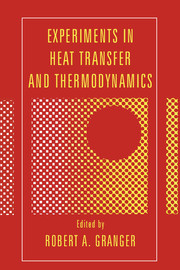Book contents
- Frontmatter
- Contents
- Preface
- Introduction
- Part I Experiments in heat transfer
- I.1 Conduction
- I.2 Convection
- I.3 Boiling
- I.4 Mixing, dispersion, and diffusion
- I.5 Radiation
- I.6 Heat pipes and exchangers
- Part II Experiments in thermodynamics
- Appendix 1 Experiments and demonstrations in thermodynamics
- Appendix 2 Experiments and demonstrations in heat transfer
- Appendix 3 Heat-transfer and thermodynamic films
- Index
Introduction
Published online by Cambridge University Press: 05 June 2012
- Frontmatter
- Contents
- Preface
- Introduction
- Part I Experiments in heat transfer
- I.1 Conduction
- I.2 Convection
- I.3 Boiling
- I.4 Mixing, dispersion, and diffusion
- I.5 Radiation
- I.6 Heat pipes and exchangers
- Part II Experiments in thermodynamics
- Appendix 1 Experiments and demonstrations in thermodynamics
- Appendix 2 Experiments and demonstrations in heat transfer
- Appendix 3 Heat-transfer and thermodynamic films
- Index
Summary
Background
Engineering students are unique. They are usually uninterested in a problem unless they can visualize it. There are two ways visualization can be accomplished. One can create a mathematical model where mathematical symbols simulate properties, devices, and behaviors, or one can create the engineering problem in the laboratory. The former is usually faster and easier for the teacher, and the latter appears to be disappearing from educational institutions due to the ease and familiarity with the computer.
Motivation
The motivation behind this book is based on three quotations:
The most effective method ever devised for teaching science – having students do experiments in a classroom laboratory to enable them to see the results – is slowly vanishing from American schools.
Boyce Rensberger, Washington Post, 11/12/88Some schools have abandoned experiments in the lab in favor of simulated experiments on a computer that displays set-ups. This kind of thing is no substitute for a teacher or for a real lab.
George Tressel, Staff Associate of NFS's Education and Human Resources DivisionI hear and I forget. I see and I remember. I do and I understand.
Old Chinese proverbSurely excellence in instruction is at the very root of education, and of necessity demands the maintenance of good academic standards. In that light, it follows that performing experiments is the grist of engineering. Nothing can be more significant than the marriage of excellent instruction incorporating well-defined academic standards with student involvement in the laboratory, that is, having the student put that instruction to practical use.
Information
- Type
- Chapter
- Information
- Experiments in Heat Transfer and Thermodynamics , pp. xv - xxPublisher: Cambridge University PressPrint publication year: 1994
Accessibility standard: Unknown
Why this information is here
This section outlines the accessibility features of this content - including support for screen readers, full keyboard navigation and high-contrast display options. This may not be relevant for you.Accessibility Information
- 1
- Cited by
